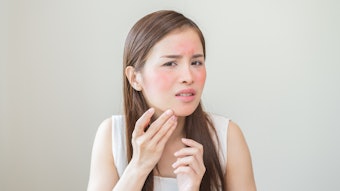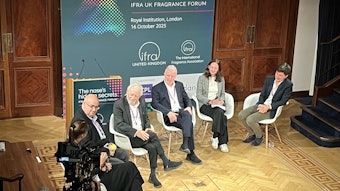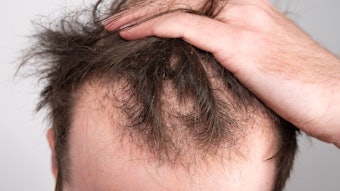Aquaporins (AQPs) are integral membrane proteins that form pores in the membrane of biological cells. At least 13 mammalian AQPs (AQP0–AQP12) have been identified and divided into two groups on the basis of their permeability. AQPs 1, 2, 4, 5 and 8 function primarily as water-selective transporters; AQPs 3, 7, 9 and 10, termed aquaglyceroporins, transport water as well as glycerol and possibly other small solutes.
Keratinocyte Differentiation
LVMH Recherche–Parfums et Cosmétiques and Chesebrough-Ponds are two personal care companies with patent histories in raw materials and cosmetic compositions for regulating skin cell growth.
More than a decade ago, French researchers at LVMH described the use of an ecdysteroid for the preparation of cosmetic or dermatological compositions intended specifically for strengthening the water barrier function of the skin. Ecdysteroids are hormones that regulate keratinocyte differentiation in humans. This differentiation manifests itself at the epidermal level in greater cellular cohesion; in the regulation of keratinocyte transformation into corneocytes, through loss of the nucleus and increase in cellular cornification; and in an increase in the number of layers of corneocytes forming the cornified layer.
In the epidermis, these phenomena collectively contribute to give the skin a smoother and softer appearance, to strengthen the protective function of the skin with respect to the external environment, and to strengthen the water barrier, preventing excessive water loss. In the hair follicle, they regulate or even increase the synthesis by keratinocytes of keratin, the main constituent of the pilar shaft of each individual hair. Also, according to this 1997 patent, these compositions enable the restoration of normal keratinocyte differentiation, and therefore could be intended for the treatment of psoriatric skin.
One year later, a Chesebrough-Ponds patent6 disclosing cosmetic compositions containing phytovitamin D3 contained a discussion of keratinocytes, which constitute 75–80% of the total number of cells in the human epidermis. Within the epidermis, the keratinocytes reside in four distinct stages of differentiation.
• The basal layer rests on the basal lamina, separating the epidermis from the dermis. These cells are large columnar, rapidly proliferating cells. These basal cells migrate upward within the epidermis, initiated by the process of differentiation.
• The layer above the basal cells is the spinous layer. The cells in the spinous layer initiate the production of proteins characteristic of the differentiated epidermis.
• The granular layer, lying above the spinous layer, is characterized by electron-dense granules. This layer is responsible for the synthesis of lipid molecules required for the formation of the water-impermeable barrier of the skin.
• The topmost layer of the skin, the stratum corneum, is formed from the granular layer by the destruction of cellular organelles. Corneocytes, which are the cells in the stratum corneum, contain extensively cross-linked proteins, surrounded by a highly resistant cell envelope. The corneocytes are embedded in a bed of specific lipid structures (analogous to bricks on a bed of mortar) and this structure provides the protective barrier for the skin. The outermost layer of corneocytes is peeled off from the skin during the normal process of desquamation.
Differentiation of the epidermal keratinocytes is the driving force for the normal desquamation process to occur, asserted the inventors at Chesebrough-Ponds. Epidermal differentiation is important for providing the essential function of the skin, namely to provide a protective barrier against the outside environment and to prevent loss of water from the body.
Chesebrough-Ponds returned to this theme in 2001 with the observation that agents that increase the thickness of the dermal layer and increase the differentiation of keratinocytes in the epidermal layer should be ideal compounds for providing skin conditioning and antiaging benefits. The agent of study in this patent7 was resveratrol.
A 2006 LVMH patent8 disclosed cosmetic uses of particular extracts of the plant Ajuga turkestanica, containing one part by weight of ecdysteroids to 2–4 parts by weight of iridoids as cosmetic agents for improving the differentiation of keratinocytes and additionally for regulating water fluxes and water absorption in the epidermis or for hydrating the epidermis. The extract of Ajuga turkestanica used in the mascara of
Formula 1 is obtained with a solvent composed of 80% acetone and 20% water. In the antiaging emulsion of Formula 2, the first six ingredients are various ecdysteroids. Ecdysteroids are molting hormones in insects. The iridoids in Formula 2 are harpagide and 8-O-acetylharpagide. Iridoids are organic compounds that are not directly involved in the normal growth, development or reproduction of organisms. Both ecdysteroids and iridoids sometimes function as protection agents in plants.
These patents demonstrate that the idea of regulating keratinocyte differentiation for medical or cosmetic purposes has been around for at least a decade. Not until recently was there an explanation for how that regulation occurs. For this explanation and for the role that an aquaporin plays, we turn to cell physiologist Wendy B. Bollag, PhD, of the Institute of Molecular Medicine and Genetics at the Medical College of Georgia.
A Signaling Module to Affect Keratinocyte Function
Bollag and her colleagues have developed a technology to regulate skin cell growth. They discovered a cell signaling pathway that plays a key role in keratinocyte proliferation and differentiation. It is centered on phospholipase D2 (PLD2), an enzyme that manipulates phospholipids, with a particular target being phosphatidylcholine, a major component of biological membranes.
In the presence of glycerol—which gains intracellular access via the aquaporin AQP3 transport channels—PLD2 catalyzes the replacement of choline (Figure 1) with glycerol to produce phosphatidylglycerol (PG). PG in turn regulates keratinocyte differentiation. Indirectly, via downstream effects on mitochondrial function and mitotic progression, PG also regulates keratinocyte proliferation in growth-inhibited cells.
“This signaling module is important for well-regulated skin growth, with PG being the critical effector,” says Bollag. “We have shown that direct provision of PG can normalize both over- and under-proliferation: it down-regulates growth in rapidly proliferating keratinocyte cell cultures and up-regulates growth in slowly proliferating cultures.” This pattern is illustrated in Figure 2.
Applying the Technology for Regulating Skin Cell Growth
Atlanta, Georgia-based Apeliotus Technologies is working with Bollag and the Medical College of Georgia to explore applications of this technology for skin disorders associated with abnormal proliferation such as psoriasis, non-melanoma skin cancers, chronic wound healing and skin aging.
Normally the epidermis is completely replaced every 30 days. New cells are continuously generated from a single, proliferating basal layer, and follow an outward migration and differentiation path until they eventually flake off from the skin surface.
Psoriasis and non-melanoma skin cancers are characterized by an abnormally rapid growth cycles. Chronic wound healing and skin aging are characterized by an abnormally slow growth cycle. Not surprisingly, these same conditions are linked to impairment of the glycerol-AQP3-PLD2-PG pathway, according to Apeliotus documents. For example, there is an established link between senescence and reduced PLD2 activity, which may contribute to slow wound healing in older adults.
Similarly, AQP3 expression is up-regulated by the UV radiation in sunlight that causes photoaging. Also, the altered calcium concentrations in psoriatic skin affect both AQP3 and PLD2 function. Thus, short-circuiting the glycerol-AQP3-PLD2-PG pathway by simple topical application of PG may benefit many skin disorders, according to John G. Edwards, CEO of Apeliotus Technologies.
“Indeed, Dr. Bollag has shown that topical application of PG reduces inflammation and accelerates wound healing in animal models,” Edwards says. “Furthermore, PG may be useful in maintaining healthy skin. Glycerol, or glycerin as it is sometimes called, has long been a principal ingredient in cosmetics and skin creams based on the empirical observation that it improves skin function. PG should be more effective for older adults, where PLD2 is less active and hence less efficient in processing glycerol.”
A Dissenting View
In their recent review4 of the role of AQP3 in the epidermis, Hara-Chikuma and Verkman of the University of California at San Francisco Department of Medicine challenged the Bollag model on three grounds based on their own human epidermis cell culture models and mouse studies using wild-type epidermis in which AQP3 was functioning normally, and AQP3-null epidermis in which AQP3 activity had been suppressed.
First, Hara-Chikuma and Verkman found little difference in lipid composition between wild-type epidermis and AQP3-null epidermis. Second, Hara-Chikuma and Verkman question the plausibility of an AQP3–PLD2 module because glycerol is freely diffusible.
Bollag responds, “This may explain why supplementation with exogenous glycerol can correct the AQP3 null defects. In other words, we hypothesize that AQP3 ‘funnels’ glycerol to PLD2 to make the production of the PG signal more efficient. However, if one increases intracellular glycerol sufficiently, this ‘funneling’ effect may no longer be necessary, such that supplementation may allow production of PG even without AQP3.”
Third, Hara-Chikuma and Verkman noted that in primary keratinocyte cultures, glycerol supplementation corrected the defects in keratinocyte proliferation; it also reduced the generation of adenosine-5′-triphosphate (ATP), the nucleotide that transports chemical energy within cells for metabolism. These two effects provide evidence for the involvement of AQP3-facilitated glycerol transport in ATP generation and keratinocyte proliferation. Further studies revealed correlations between cell proliferation, and ATP and glycerol concentrations. Oral glycerol administration also corrected the impaired epidermal proliferative response in the epidermis of AQP3-null mice.
Although multiple studies showed involvement of AQP3 in epidermal cell proliferation, the data provided direct evidence against AQP3 involvement in epidermal cell differentiation, according to Verkman. Regarding the reduced generation of ATP, Bollag responds,
“I think that Dr. Verkman’s group showed that glycerol supplementation increased ATP generation, which was reduced in the AQP3-null mouse.”
Comment
Some questions remain to be answered, but at least cosmetic formulators and consumers may now have a better idea of how their old friend glycerol has a positive effect on human skin. And persons with diseased, aged or sun-damaged skin may have a way to bypass a malfunctioning pathway that produces a signal that regulates skin cell growth and simply delivers the signal instead.
References
Send e-mail to [email protected].
1. B Brewster, Aquaporins: The one-molecule-at-a-time moisturizer, Cosmet Toil 123(5) 24–32 (2008)
2. B Brewster, Aquaporins: Stimulating AQP3, Cosmet Toil123(6) 20–26 (2008)
3. P Agre, The aquaporin water channels, Proc Am Thorac Soc 3(1) 5–13 (2006)
4. M Hara-Chikuma and AS Verkman, Roles of Aquaporin-3 in the epidermis, (In press at J Invest Derm)
5. US Pat 5,609,873, Use of an ecdysteroid for the preparation of cosmetic or dermatological compositions intended, in particular, for strengthening the water barrier function of the skin or for the preparation of a skin cell culture medium, as well as to the compositions, A Meybeck, F Bonte and G Redziniak, Assigned to LVMH Recherche (Mar 11, 1997)
6. US Pat 5,776,461, Cosmetic compositions containing phytovitamin D, S Pillai et al, Assigned to Chesebrough-Pond’s USA Co, Division of Conopco (Jul 7, 1998)
7. US Pat 6,270,780, Cosmetic compositions containing resveratrol, RG Carson et al, Assigned to Chesebrough-Pond’s USA Co, Division of Conopco (Aug 7, 2001)
8. US Pat 7,060,693, Ajuga turkestanica extract and its cosmetic uses, M Dumas, F Bonte and C Gondran, Assigned to LVMH Recherche (Jun 13, 2006)










